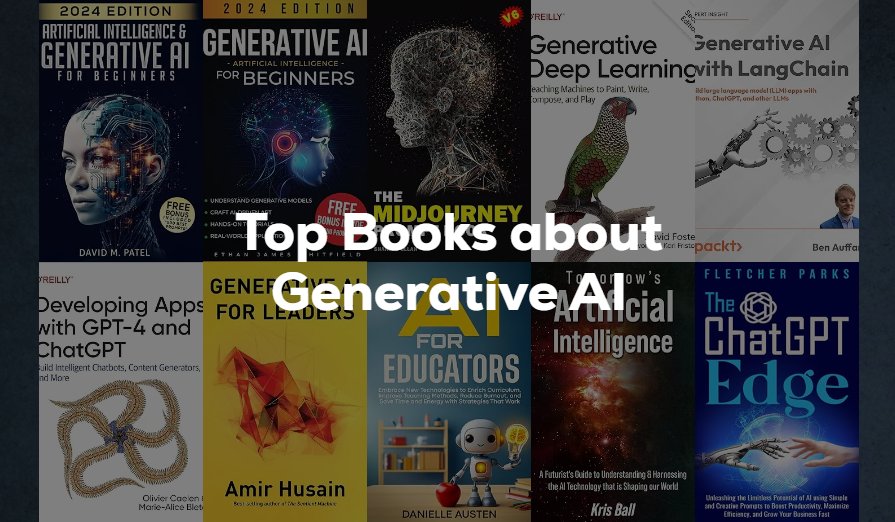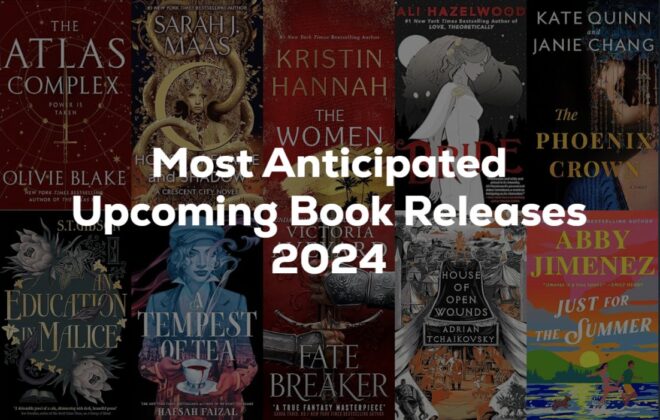Top 8+ Books about Generative AI (2024) · LLMs, GPTs, Diffusion Models
Generative AI isn't new, I wrote a longer article about GANs (as we called them several years before) but in 2022 it reached a certain level of quality, that impressed the world. In addition the emergence of ChatGPT (GPT 3.5) and Large Language Models became part of this trend that we call “Generative AI”.
What Techs Are Part of Generative AI?
We can find several ways to categorize these technologies, but I think the easiest way to understand them is if we use output categorization: what will be the actual output of these AI models?
Using this logic there are AI models for
- Image generation · Diffusion models
- Text generation · Large Language models
- Video generation · Large-scale Video Generation models
- Speech or audio generation · Diffusion models
Most important applications of Generative AI
I did collect the most notable AI applications, that are robust enough and they aren't using any third party services. This is my private collection, I also use the majority of these tools personally:
- OpenAI ChatGPT · GPT-4 (text to text) · LLM (2024)
- Google Gemini (text to text) · LLM (2024)
- Claude.ai (text to text) · LLM (2023)
- PI.ai (text to text) · LLM (2023)
- Github Copilot (text to text/code) · LLM (2023)
- Dall-E 3 (text to image) · Diffusion Model (2023)
- Stable Diffusion Pro Max (text to image) · Diffusion Model (2023)
- Midjourney (text to image) · Diffusion Model (2022)
- OpenAI Sora (text to video) · Large-scale Video Generation model (2024)
- Runway (text to video) · Large-scale Video Generation model (2023)
- Lovo.ai (text to speech) · Voice model (2023)
- Amazon Polly (text to speech) · Voice model (2022)

What Are Prompts?
Think of a prompt like asking your friend a question or telling them to do something. When you use an AI, you write then prompts. For example if you would like to
This can be anything from a question you want answered to a request for it to make something, like a story or a picture. The AI then tries to figure out what you're asking for and gives you back an answer or something new based on what you told it. How well you ask or tell the AI what you want can make a big difference in what you get back.
What are the best Generative AI Books for Image and Text Generation?

Artificial Intelligence & Generative AI for Beginners (Generative AI & Chat GPT Mastery Series Book 1), by David M. Patel (2023)
David M. Patel's book is a straightforward guide that helps readers get to grips with artificial intelligence and generative AI. Patel, an Amazon bestselling author and AI consultant, aims to make complex AI concepts accessible to everyone, whether you're starting from scratch or looking to expand your professional skills. The book covers the basics of AI, including its history and main components, and explains different types of machine learning. It also introduces readers to critical AI fields such as natural language processing, computer vision, and robotics, showing how they apply in the real world. Patel's approach is to give readers the knowledge they need to use AI tools like ChatGPT, DALL-E 3, and MidJourney effectively, helping them boost their productivity and achieve personal or business growth.
Patel focuses on generative AI, explaining what it is, how it works, and the various types that exist. He offers practical advice on how to come up with business ideas using generative AI and guides readers through building their own generative AI models.
The book also covers how generative AI can be applied in areas such as copywriting, graphic design, and video editing. It raises important ethical questions about AI and predicts how generative AI will change industries like healthcare, media, and education. Patel provides a wealth of resources for readers who want to explore further, including podcasts and influencers in the AI field.

Generative AI for Beginners, by Ethan James Whitfield (2023)
Generative AI for Beginners is a book designed to simplify these complexities, making the world of Generative AI approachable for everyone. It aims to alleviate the frustration of not grasping this transformative technology, which can hinder personal and professional growth.
The book covers the basics of Generative AI, including its principles and how it works, along with its impact across various industries. It goes beyond theory, showing how Generative AI is applied in creating art, music, and written content, and highlights the importance of ethical considerations in AI use. Tailored for absolute beginners, the book promises a clear and straightforward learning journey, fitting easily into busy schedules. It positions itself as a tool for anyone looking to understand and engage with the ongoing AI revolution, offering a pathway to new career opportunities and a deeper appreciation of how AI is reshaping our world.

The Midjourney Prompt Book, by Shaheed Ullah (2024)
This comprehensive guide covers the advanced knowledge of Midjourney prompts, including commands and parameters with detailed step-by-step instructions and practical tips. I found over a thousand prompts that fit also for Stable Diffusion XL and DALL.E-3, despite being designed for Midjourney.
The book, now in its 6th edition, spans 300 pages across eleven chapters. It includes a newly added chapter on Nature, Commercial, and Fashion Photography, and another dedicated to Building Consistent Characters with Midjourney, catering to both beginners and advanced users.
This edition discusses the latest Midjourney's Niji models along with advanced prompts, photorealism, and niche-specific guides.
What are the best Generative AI Books to Understand the Technology Behind It?

Generative Deep Learning, by David Foster (2023)
This book aims to equip machine learning engineers and data scientists with the skills to build cutting-edge generative AI models using TensorFlow and Keras. It starts with the fundamentals of deep learning and gradually progresses to complex architectures like VAEs, GANs, and Transformers. Through practical guidance and expert tips, you'll learn to unlock the creative potential of these models, generating images, music, text, and even solving reinforcement learning tasks. The book also delves into the future of generative AI and its potential impact on individuals and businesses.
In essence, this book is a hands-on guide to building and harnessing the power of generative AI, equipping readers with the knowledge and skills to explore this exciting field.

Generative AI with LangChain, by Ben Auffarth (2023)
This book guides readers through the process of mastering the LangChain framework, bridging the gap between the theoretical aspects of Large Language Models (LLMs) and their practical deployment in creating applications ready for production. The book offers updated code examples on GitHub to keep readers informed about the latest in LangChain developments and includes a free PDF eBook with the purchase of the print or Kindle version. It covers how to harness the capabilities of LLMs while navigating their limitations, using the LangChain framework for various tasks such as customer support, software development help, and data analysis, showcasing the wide-ranging utility of LLMs in real-world applications.
Designed for developers, researchers, and anyone keen to deepen their understanding of LLMs, the book provides a thorough exploration of generative AI fundamentals, industry trends, and the construction of responsive LLM applications. It teaches about transformer models, attention mechanisms, and how to automate data analysis with Python, offering insights into improving LLM performance and deploying these models effectively.
With a basic requirement of Python knowledge and a suggestion of some machine learning background, this guide is a valuable asset for those looking to enhance their skills in the dynamic field of LLMs and LangChain, positioning them at the forefront of technological innovation.

Developing Apps with GPT-4 and ChatGPT, by Olivier Caelen (2023)
Developing Apps with GPT-4 and ChatGPT is a comprehensive guide aimed at Python developers interested in leveraging large language models for application development. Authored by Olivier Caelen and Marie-Alice Blete, the minibook delves into the functionalities and advantages of GPT-4 and ChatGPT, offering a clear explanation of their operations. It serves as a practical handbook, providing readers with a detailed tutorial on how to use the GPT-4 and ChatGPT Python library for a variety of tasks, including text generation, question answering, and content summarization.
The authors ensure clarity and accessibility in their writing, supplementing theoretical knowledge with easy-to-follow examples, all of which are supported by Python code available in a dedicated GitHub repository.
What are the best Generative AI Books to Understand the Social Impact?

Generative AI for Leaders, by Amir Husain (2023)
Generative AI is shaping our future, and this guidebook is here to help organizations make the most of it. Written in clear, straightforward language, Generative AI for Leaders covers the basics of what Generative AI is, its advantages like boosting productivity and sparking new product ideas, and the challenges it brings, including bias and security issues. It outlines steps for creating a strategy that makes an organization stand out, how to put together the right team, and when to get outside help. The book goes beyond the basics, giving a closer look at the technical side of things like word embeddings and large language models, and discusses how to spot the use of Generative AI.
The future of Generative AI is exciting, and the book doesn't stop at theory. It offers over 75 practical ideas that leaders can start using right away to integrate Generative AI into their operations. By focusing on real-world applications and addressing both the opportunities and hurdles of Generative AI, the guide aims to prepare leaders for what's coming. It's about making informed decisions, understanding the technology, and using it to improve and innovate, ensuring organizations are ready for the future.

Ai For Educators, by Danielle Austen (2024)
When I first found this book I thought finally a domain specific approach for AI. Teachers are at the heart of the education system, dedicating their lives to shaping the future one student at a time. They go above and beyond to make sure every lesson resonates and every student feels valued. Despite their passion, the reality of being a teacher often means facing exhaustion from balancing lesson planning, administrative duties, grading, and endless parent-teacher meetings.
Every student requires individual attention, and the desire to make a real difference sometimes comes at the cost of a teacher's well-being. It's concerning that 42% of teachers feel a high level of stress daily, which steals their time, energy, and the joy that initially drew them to this noble profession.
Artificial Intelligence is emerging as a supportive ally in the educational field, offering a helping hand to teachers. It proposes a way to simplify their workload rather than complicate it. AI can handle repetitive tasks, adapt lessons to meet each student's needs without extra effort from teachers, keep student data safe, and make learning more engaging. This shift towards using AI in education can reduce the long hours teachers work and help avoid burnout.
Final Thoughts on Books about Generative AI
As I wrap up this exploration of the top Generative AI books, I'm struck by the pace at which the field is advancing. Each book has offered a unique perspective, from technical development to using prompts that utilizes models like GPT-4. I can't stop thinking how it will feel like using a real AGI (Artificial General Intelligence), maybe as it was described in Conjunction (a visionary sci-fi).
This AI journey excitement about the possibilities that Generative AI holds for the future. The rapid evolution from early GPT models to the sophisticated diffusion models of today illustrates a trajectory of innovation that's far from plateauing. The knowledge encapsulated in these books equips us with the understanding to not only participate in this transformation but to drive it forward. As a developer, a creator, or simply an enthusiast of AI, the road ahead is rich with potential, and I'm eager to see how we'll continue to push the boundaries of what's possible with Generative AI.
If you are looking for more AI related reads check my ultimate selection of AI books (which also includes fiction books).
My profession is online marketing and development (10+ years experience), check my latest mobile app called Upcoming or my Chrome extensions for ChatGPT. But my real passion is reading books both fiction and non-fiction. I have several favorite authors like James Redfield or Daniel Keyes. If I read a book I always want to find the best part of it, every book has its unique value.







